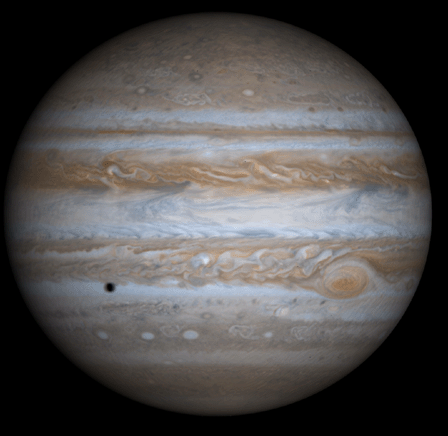 |
(To left, from the Galileo Project, http://www.jpl.nasa.gov/pictures/jupiter/ above, an Indian miniature painting of Brihaspati, the planet Jupiter, divine sage and tutor of the Gods, from The Black Peacock, http://www.goloka.com/index.html) |
Key points: "Weather" features; internal energy; nature of surface; interior composition; contrast of a giant planet with the terrestrial ones
Jupiter is the largest planet in the Solar System (as massive as all the rest together). It is is a "giant planet," with very different properties from the "terrestrial" planets we have studied so far.
 |
(To left, from the Galileo Project, http://www.jpl.nasa.gov/pictures/jupiter/ above, an Indian miniature painting of Brihaspati, the planet Jupiter, divine sage and tutor of the Gods, from The Black Peacock, http://www.goloka.com/index.html) |
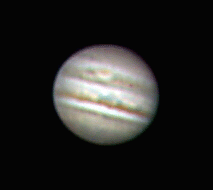 |
Jupiter rotates in 9 hr 50 minutes at its equator. However, careful observation shows that the rotational rate is slower moving towards the pole -- 9 hr 56 minutes. |
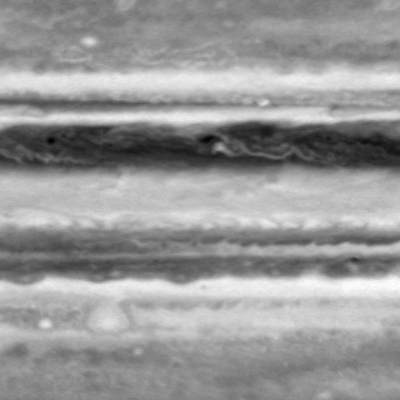 |
This effect of rotation rate varying with latitude is
called differential rotation. It is dramatized here by "freezing" the
polar motions and letting the rest move relatively. (From
NASA, JPL, Cassini/Huygens Project, http://saturn.jpl.nasa.gov/index.cfm)
|
Differential rotation implies that we are not seeing a solid surface, which would have to have a constant rotational speed.
| Jupiter's atmosphere displays colored bands and changing features indicative of weather. The Galileo orbiter has returned images of cloud tops that look very similar to thunderheads on Earth. | 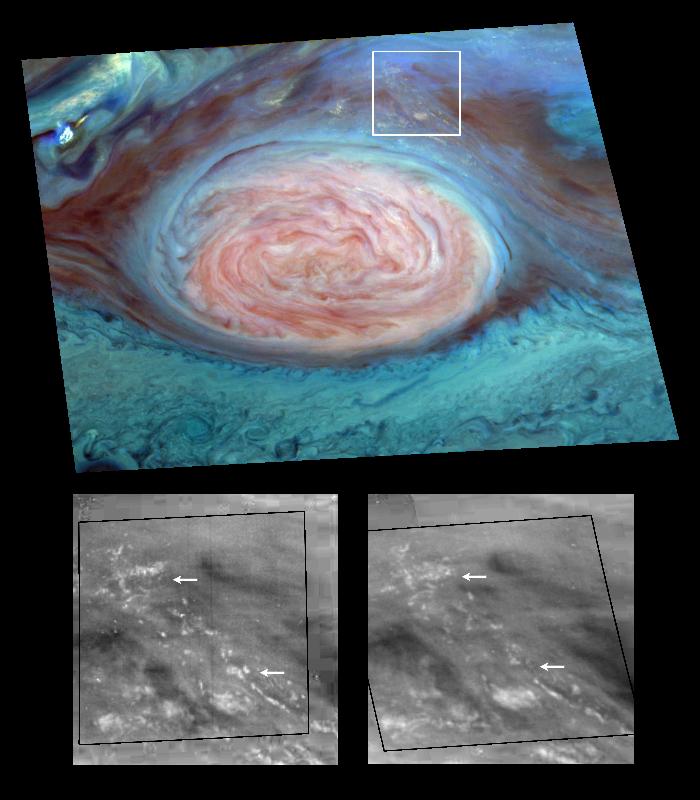 |
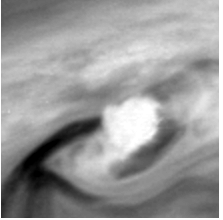 |
The exact cause of the colors is still not understood but they are likely to result from sulfur or phosphorus compounds found in trace amounts. Light colored clouds are ammonia ice crystals. The clouds show powerful turbulent motions indicating high winds. (all from Galileo Project) |
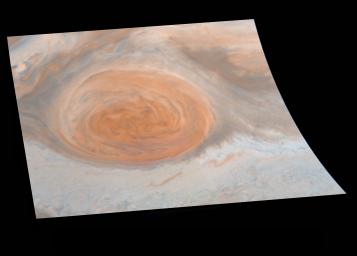 |
Storms have been seen to last for very long times -- the Great Red Spot has existed for over 300 years. (NASA via Astronomy Picture of the Day)
Voyager images of the Great Red Spot showed a whirlpool character confirming that it is a large high-pressure cell like some on Earth.
|
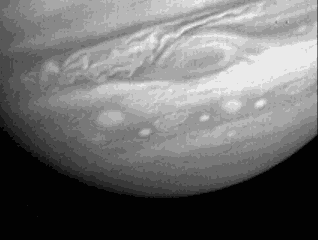 |
The inner terrestrial planets have a close balance between the energy absorbed from the sun and the energy radiated into space.
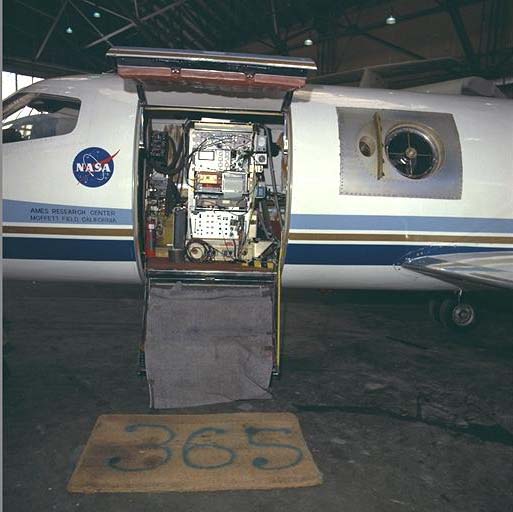 |
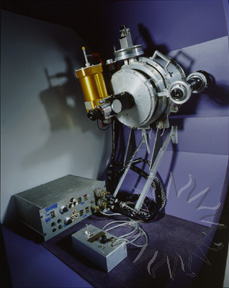 |
To observe in the far infrared, in 1969 a 12 inch telescope was mounted in the escape hatch of a Lear Jet so it could be carried above most of the atmosphere (which absorbs far infrared light) (from http://www.nasm.si.edu/research/dsh/artifacts/SS-LearJetScope.htm). It was discovered that Jupiter emits twice as much energy as it absorbs from the sun. Subsequently, it was found that Saturn and Neptune (but not Uranus) also emit about twice as much energy as they absorb from the sun.
For Jupiter, this can be trapped heat from the time of its formation; the cause is not well understood for Saturn and Neptune.
Not long after the Galileo mission arrived at Jupiter, a probe that fell through the atmosphere was released. As the probe fell, it returned data on temperature, pressure, composition, wind speeds, and prevalence of clouds. These results showed that
| Jupiter has the strongest magnetic field of any body in the solar system. The magnetic field on Jupiter implies that it must contain a liquid metal which contradicts expectations from its density. However, at a depth of ~15,000 km below its cloud tops, the pressure becomes so great that hydrogen becomes a liquid metal (a rarity because both temperature and pressure must be very high). "Metallic" in this sense means it conducts electricity readily. Most of the interior of Jupiter is in this state. (http://www2.jpl.nasa.gov/galileo/jupiter/interior.html) | 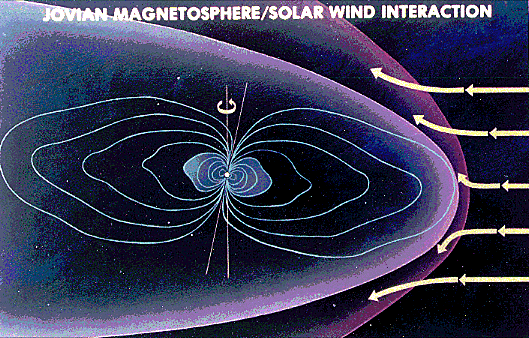 |
| Jupiter also has aurorae similar to those on Earth. (http://nssdc.gsfc.nasa.gov/photo_gallery/photogallery-jupiter.html) | 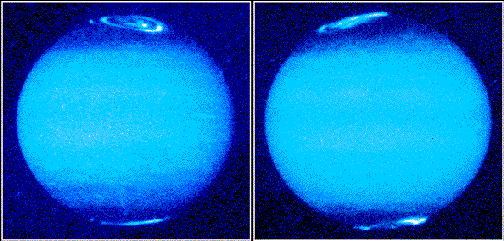 |
| We do not believe Jupiter has any solid surface (despite what you may have seen in the movies!). Instead, the "surface" is probably liquid molecular hydrogen under great pressure from the thick atmosphere. Perhaps it would look like this artist's concept! |  |
 |
We believe that far below this liquid hydrogen "mantle" the pressure is so great that the hydrogen changes state to become electrically conductive, resulting in the strong magnetic field. We suspect that the rocky materials have settled into a core not too different in size than the earth, but dwarfed in this case by the overlying layers of hydrogen and helium. |
Test your understanding before going on![]()
 Horus,
Egyptian god of Mars, http://grenier2clio.free.fr/egypte/horus.htm Horus,
Egyptian god of Mars, http://grenier2clio.free.fr/egypte/horus.htm |
Shani, Vedic god of Saturn, http://www.payer.de/kommkulturen/kultur123.htm |
|
Click to return to syllabus |
||
| Click to return to Mars | hypertext |
Click to go to Saturn, Uranus, and Neptune |